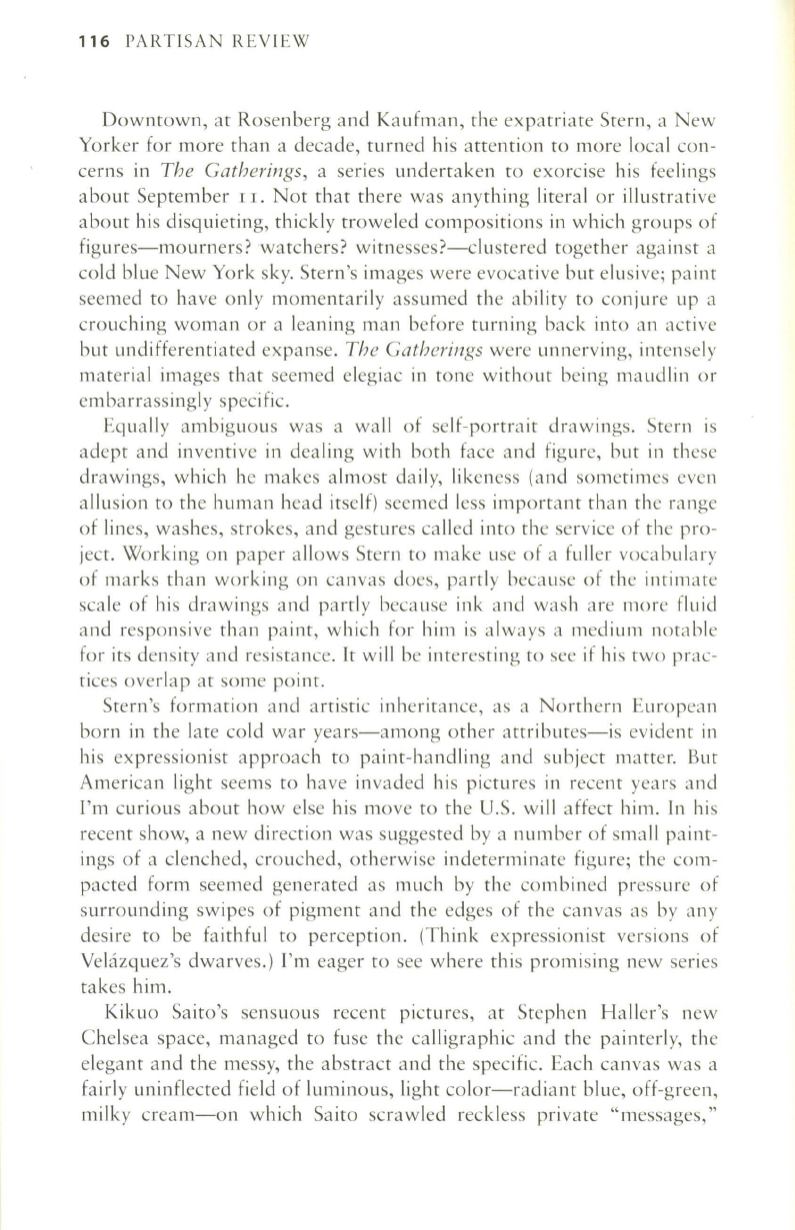
116
PARTISAN REVIEW
Downtown, at Rosenberg and Kaufman, the expatriate Stern, a New
Yorker for more than a decade, turned his attention to more local con–
cerns in
The Gatherings,
a series undertaken to exorcise his feelings
about September
II.
Not that there was anything literal or illustrative
about his disquieting, thickly troweled compositions in which groups of
figures-mourners? watchers? witnesses?-c1ustered together against a
cold blue New York sky. Stern's images were evocative but elusive; paint
seemed to have only momentarily assumed the ability to conjure up a
crouching woman or a leaning man before turning back into an active
but undifferentiated expanse.
The Gatherings
were unnerving, intensely
material images that seemed elegiac in tone without being maudlin or
embarrassingly specific.
Equally ambiguous was a wall of self-portrait drawings. Stern is
adept and inventive in dealing with both face and figure, but in these
drawings, which he makes almost daily, likeness (and sometimes even
allusion to the human head itself) seemed less important than the range
of lines, washes, strokes, and gestures called into the service of the pro–
ject. Working on paper allows Stern to make use of a fuller vocabulary
of marks than working on canvas does, partly because of the intimate
scale of his drawings and partly because ink and wash are more fluid
and responsive than paint, which for him is always a medium notable
for its density and resistance.
It
will be interesting to see if his two prac–
tices overlap at some point.
Stern's formation and artistic inheritance, as a Northern European
born in the late cold war years-among other attributes-is evident in
his expressionist approach to paint-handling and subject matter. But
American light seems to have invaded his pictures in recent years and
I'm curious about how else his move to the U.S. will affect him.
In
his
recent show, a new direction was suggested by a number of small paint–
ings of a clenched, crouched, otherwise indeterminate figure; the com–
pacted form seemed generated as much by the combined pressure of
surrounding swipes of pigment and the edges of the canvas as by any
desire to be faithful to perception. (Think expressionist versions of
Velazquez's dwarves.) I'm eager to see where this promising new series
takes him.
Kikuo Saito's sensuous recent pictures, at Stephen Haller's new
Chelsea space, managed to fuse the calligraphic and the painterly, the
elegant and the messy, the abstract and the specific. Each canvas was a
fairly uninflected field of luminous, light color-radiant blue, off-green,
milky cream-on which Saito scrawled reckless private "messages,"


